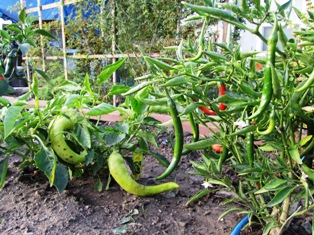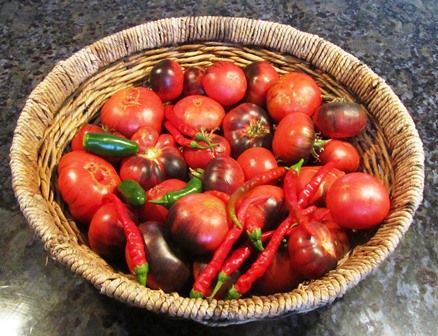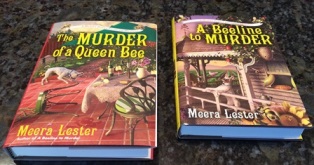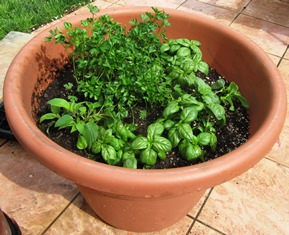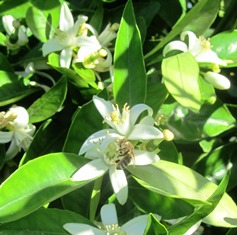Planting the Spring Garden
Winter brought us lots of rain and now the ground has warmed up and is ready to receive the heirloom seedlings of our favorite vegetables and herbs.
Tomatoes won’t set fruit until the nighttime temps hover around 55 degrees Fahrenheit, but I tucked in several seedlings of heirloom varieties (Bradley, Cherokee Purple, and Red Beefsteak). Victory Seeds offers a nice selection of open-pollinated, non GMO, rare heirloom seeds for a variety of tomatoes. See, http://www.victoryseeds.com/tomato.html
While I was digging, my neighbor’s bees decided to swarm. So I stopped gardening to check on my own bees. They’ve been humming like a truck engine, and there has been a lot of bee traffic. Concerned that they might swarm, I set aside my shovel and got out the swarm catcher, the lemon oil, and the hand pump sprayer. I positioned the swarm catcher in a tree across the yard, sprayed the tree with lemon oil, and went back to gardening.
I’ve readied a patch of ground for the sweet corn, squash, peppers, and beans. Also, in a large-size planter pot, I’ve tucked in flat Italian parsley, Italian oregano, dill, chives, and sweet basil. The patio pot will remain near the kitchen slider in full sun so I have culinary herbs at the ready when I need them.
The early sweet peas are taking off now and the garlic and onions I put in the garden last fall are about a foot high. The vegetables and herbs I plant now will provide me with plenty of nutritious offerings right up until late fall–one of the many reasons to plant a garden in spring.
Enjoy this blog? Check out my Henny Penny Farmette novels, available online and in traditional bookstores everywhere.
Heirloom Herbs for the Kitchen
The green stalks of the red and yellow onions I planted in late summer are now up about a foot in a raised bed. The garlic that I planted around the same time is also poking up. Having onions, garlic, and fresh culinary herbs available year-round is not impossible in the Bay Area’s mild climate, especially when they are grown in cold frames, protected areas, and raised beds.
Some will re-seed themselves in the growing beds or around your yards. We’ve got Greek oregano and chives growing all over the place. Some of my favorites herbs include basil, cilantro, chervil, chives, dill, fennel, lemon balm, lavender, oregano, mint, marjoram, rosemary, thyme, parsley, sage, and savory.
We also grow a few ornamental herbs such as borage, hyssop, and catnip (for our new kitty), tea herbs (chamomile and mint), and medicinal herbs (like echinacea).
Herbs are easy to grow. Their blooms will attract insects beneficial to the garden. Butterflies and hummingbirds are also attracted. And herbs don’t need much–light, and porous soil, warmth, and decent drainage. For a light feeding of the herbs, we make chicken poop tea. With so many varieties of herbs available, why not tuck a few in your garden or in containers in a protected but sunny and warm area of your patio to enjoy in your culinary creations?
Edible Flowers Add Flavor and A Flourish
Picture a red nasturtium or peppery-tasting marigold displayed around a mound of lemony-yellow butter. Or, imagine the beauty of a handful of sugared purple violets or red rose petals, sans the sour petal base, crowning an iced picnic cake.
During bygone eras when the Romans ruled the world or Queen Victoria reigned during the age named for her, flowers weren’t just for bouquets on the table, they formed an integral part of the food that was consumed.
Many flowers and seeds are poisonous, so it is imperative that you correctly identify any flower or plant you plan to eat or use on food. Also, make sure you are not allergic to the plant before integrating its blooms into your diet.
Several edible florals include the blossoms of herbs such as lavender, dill, garlic chive, coriander, basil, bee balm, marjoram, oregano, anise hyssop, winter savory, summer savory, sage, and mint. Also edible are the flowers of certain varieties of pumpkins, squash, cauliflower, scarlet runner bean, radish, sweet garden pea, and fennel.
Consider also the delicate blooms of society garlic, dianthus, pansy, signet marigold, red clover, African marigold, plum, scented geranium (rose, lemon). You can candy the blossoms of apple and crabapple, but the seeds are poisonous.
Some blooms, such as hibiscus (China rose), mint, rose, and chamomile are used to flavor teas. Lemon blossoms will have a slightly bitter taste whereas orange blossoms are sweet but both are lovely floating in crystal bowls of punch.
Research your chosen plant and correctly identify it before using it in any food preparation. See, http://www.extension.iastate.edu/publications/rg302.pdf
Also see, http://www.ext.colostate.edu/pubs/garden/07237.html
 Facebook
Facebook Goodreads
Goodreads LinkedIn
LinkedIn Meera Lester
Meera Lester Twitter
Twitter




